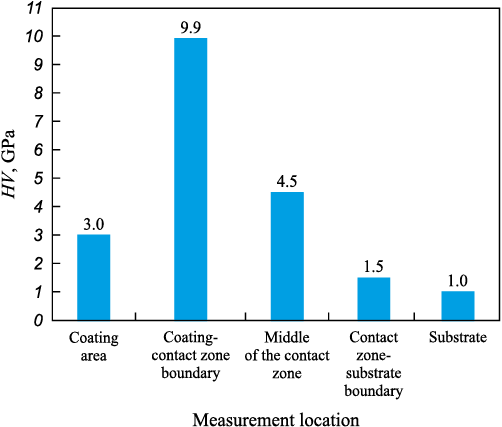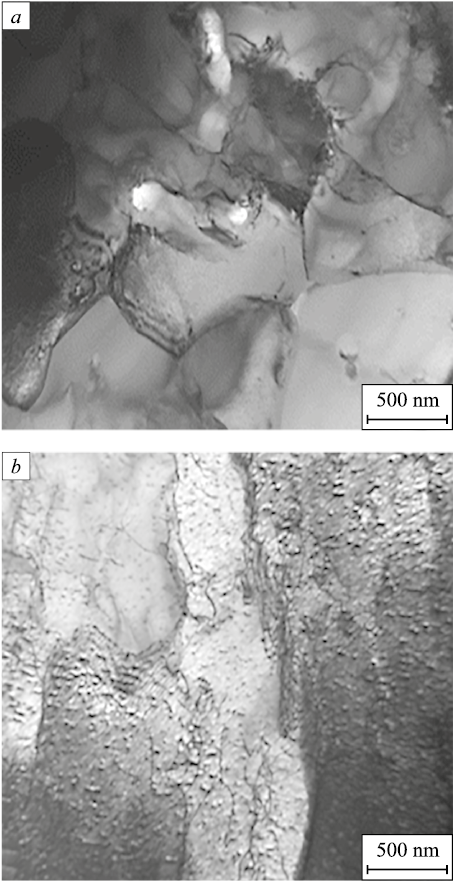Scroll to:
Gradient of microhardness in the contact zone coating (HEA CoCrFeNiMn) – substrate (alloy 5083)
https://doi.org/10.17073/0368-0797-2024-4-398-400
Abstract
In this work, a coating of a high-entropy alloy CoCrFeNiMn of non-atomic composition is formed on a substrate made of alloy 5083 by the method of wire-arc additive manufacturing (WAAM). The authors investigated the change in microhardness in the contact zone of the coating – substrate system. Using the methods of modern physical materials science, the structural and phase state, defect structure and elemental composition of the coating – substrate system were analyzed. The discovered physical mechanisms contribute to an increase in hardness in the contact zone.
For citations:
Efimov M.O., Panchenko I.A., Shlyarova Yu.A. Gradient of microhardness in the contact zone coating (HEA CoCrFeNiMn) – substrate (alloy 5083). Izvestiya. Ferrous Metallurgy. 2024;67(4):398-400. https://doi.org/10.17073/0368-0797-2024-4-398-400
In recent years, researchers in physical materials science have focused on high-entropy alloys (HEAs) [1; 2], which exhibit abnormally high values of mixing entropy, surpassing those of complex alloys. The HEA concept involves achieving maximum mixing entropy from five or more elements in various atomic ratios. This results in single-phase structures with significant lattice distortion and impeded diffusion, leading to enhanced strength properties and stability over a wide temperature range [3 – 5]. Developed HEAs show promise for applications in electronics, nuclear energy, transport engineering, aerospace, and other industries [6; 7]. The use of HEAs is expected to expand as new compositions are developed and their properties investigated. Currently, extensive information is being gathered and understood about HEA synthesis methods, structural and phase states, defect substructures, and properties.
In this study, the change in microhardness within the contact zone of the HEA CoCrFeNiMn coating on the alloy 5083 substrate was analyzed.
The study used samples of the coating-substrate system, where the coating was a non-equiatomic composition of HEA CoCrFeNiMn, formed on a substrate of alloy 5083 using wire-arc additive manufacturing [3]. The hardness of the material was determined using the Vickers method on a PMT-3 microhardness tester with a load of 5 N. Studies of structural and phase states, defect substructure, and elemental composition were conducted using transmission electron diffraction microscopy on a JEM2100 instrument.
The microhardness of the coating – substrate system varies from 9.9 GPa at the coating – contact zone boundary to 1.5 GPa at the contact zone – substrate boundary. The microhardness of the coating and substrate is 3.0 and 1.0 GPa, respectively (Fig. 1).
Fig. 1. Change in microhardness of the coating – substrate system |
The significant change in the microhardness of the contact zone is due to the structural and phase changes of the material when the coating is applied to the substrate. X-ray microanalysis confirmed the chemical homogeneity of the coating and the presence of aluminum atoms, indicating their diffusion from the substrate.
Electron microscope images of the contact zone revealed the formation of a grain-subgrain structure with crystallite sizes ranging from 0.5 to 1.1 μm (Fig. 2, a). Within the grains of such a structure, chaotic and cellular dislocation substructures with a scalar density of approximately 1010 cm\(^–\)2 are present (Fig. 2, b).
Fig. 2. Electron microscopic images of contact zone |
Particles of the second phase were found within the volume of grains and subgrains, as well as at their boundaries. The sizes of these particles in the grain volume range from 15 to 17 nm, and at their boundaries from 30 to 35 nm. Analysis of X-ray diffraction patterns established that the chemical composition of the second-phase particles is Al3Fe4 .
Plate-shaped formations were found in the contact zone on the substrate side. Analysis of dark-field images and indexing of the corresponding X-ray diffraction patterns allows us to conclude that these inclusions are iron aluminides of the composition Al3Fe4 .
Conclusions
Analysis of the phase elemental composition and defect substructure suggests that the increase in microhardness in the contact zone of the coating-substrate system is due to several factors: the formation of a submicron grain-subgrain structure containing nanosized second-phase particles, solid-solution strengthening resulting from mutual alloying of the coating and substrate, and the formation of plate-shaped iron aluminides. Additionally, differences in thermophysical characteristics between the coating and the substrate may lead to the formation of internal stress fields in the contact zone.
References
1. Zhang Y., Zuo T.T., Tang Z., Gao M.C., Dahmen K.A., Liaw P.K., Lu Z.P. Microstructures and properties of high-entropy alloys. Progress in Materials Science. 2014;61:1–93. https://doi.org/10.1016/j.pmatsci.2013.10.001
2. Rogachev A.S. Structure, stability and properties of high-entropy alloys. Physics of Metals and Metallography. 2020;121(8):733–764. https://doi.org/10.1134/S0031918X20080098
3. Gromov V.Е., Konovalov S.V., Ivanov Yu.F., Osintsev K.A. Structure and Properties of High-Entropy Alloys. Springer; 2021;107:110. https://doi.org/10.1007/978-3-030-78364-8
4. Cantor B. Multicomponent and high entropy alloys. Entropy. 2014;16(9):4749–4768. https://doi.org/10.3390/e16094749
5. Miracle D.B., Senkov O.N. A critical review of high entropy alloys and related concepts. Acta Materialia. 2017;122: 448–511. https://doi.org/10.1016/j.actamat.2016.08.081
6. Yeh J.–W. Physical metallurgy of high-entropy alloys. JOM. 2015;67(10):2254–2261. http://doi.org/10.1007/s11837-015-1583-5
7. Tsai M.–H., Yeh J.–W. High-entropy alloys: A critical review. Materials Research Letters. 2014;2(3):107–123. http://doi.org/10.1080/21663831.2014.912690
About the Authors
M. O. EfimovRussian Federation
Mikhail O. Efimov, Candidates for a degree of Cand. Sci.(Eng.) of the Chair of Science named after V.M. Finkel’
42 Kirova Str., Novokuznetsk, Kemerovo Region – Kuzbass 654007, Russian Federation
I. A. Panchenko
Russian Federation
Irina A. Panchenko, Cand. Sci. (Eng.), Head of the Laboratory of Electron Microscopy and Image Processing
42 Kirova Str., Novokuznetsk, Kemerovo Region – Kuzbass 654007, Russian Federation
Yu. A. Shlyarova
Russian Federation
Yuliya A. Shlyarova, Postgraduate of the Chair of Science named after V.M. Finkel’, Researcher of Laboratory of Electron Microscopy and Image Processing
42 Kirova Str., Novokuznetsk, Kemerovo Region – Kuzbass 654007, Russian Federation
Review
For citations:
Efimov M.O., Panchenko I.A., Shlyarova Yu.A. Gradient of microhardness in the contact zone coating (HEA CoCrFeNiMn) – substrate (alloy 5083). Izvestiya. Ferrous Metallurgy. 2024;67(4):398-400. https://doi.org/10.17073/0368-0797-2024-4-398-400


































